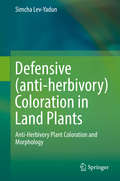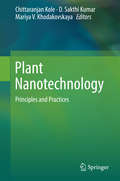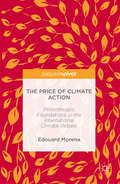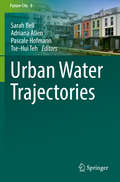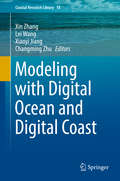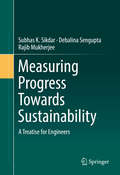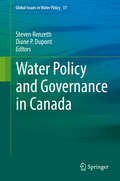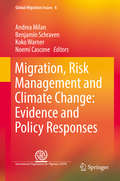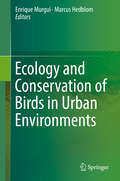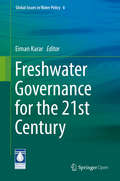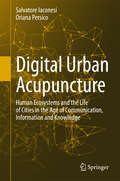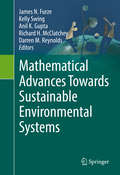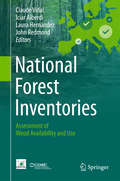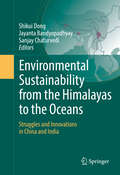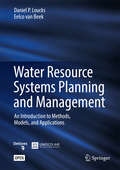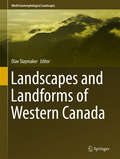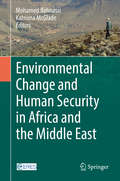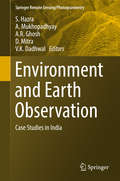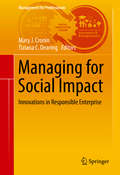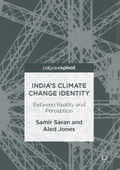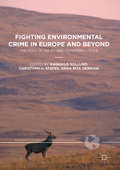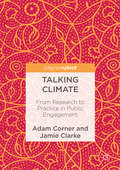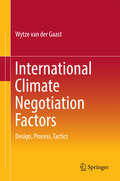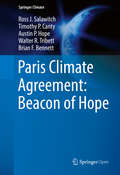- Table View
- List View
Defensive (anti-herbivory) Coloration in Land Plants
by Simcha Lev-YadunThis book presents visual plant defenses (camouflage, mimicry and aposematism via coloration, morphology and even movement) against herbivores. It is mainly an ideological monograph, a manifesto representing my current understanding on defensive plant coloration and related issues. The book is not the final word in anything, but rather the beginning of many things. It aims to establish visual anti-herbivory defense as an integral organ of botany, or plant science as it is commonly called today. I think that like in animals, many types of plant coloration can be explained by selection associated with the sensory/cognitive systems of herbivores and predators to reduce herbivory. It is intended to intrigue and stimulate students of botany/plant science and plant/animal interactions for a very long time. This book is tailored to a readership of biologists and naturalists of all kinds and levels, and more specifically for botanists, ecologists, evolutionists and to those interested in plant/animal interactions. It is written from the point of view of a naturalist, ecologist and evolutionary biologist that I hold, considering natural selection as the main although not the only drive for evolution. According to this perspective, factors such as chance, founder effects, genetic drift and various stochastic processes that may and do influence characters found in specific genotypes, are not comparable in their power and influence to the common outcomes of natural selection, especially manifested when very many species belonging to different plant families, with very different and separate evolutionary histories, arrive at the same adaptation, something that characterizes many of the visual patterns and proposed adaptations described and discussed in this book. Many of the discussed visual defensive mechanisms are aimed at operating before the plants are damaged, i. e. , to be their first line of defense. In this respect, I think that the name of the book by Ruxton et al. (2004) "Avoiding Attack" is an excellent phrase for the assembly of the best types of defensive tactics. While discussing anti-herbivory, I do remember, study and teach physiological/developmental aspects of some of the discussed coloration patterns, and I am fully aware of the simultaneous and diverse functions of many plant characters in addition to defense.
Plant Nanotechnology
by Chittaranjan Kole D. Sakthi Kumar Mariya V. KhodakovskayaThis book highlights the implications of nanotechnology in plant sciences, particularly its potential to improve food and agricultural systems, through innovative, eco-friendly approaches, and as a result to increase plant productivity. Topics include various aspects of nanomaterials: biophysical and biochemical properties; methods of treatment, detection and quantification; methods of quantifying the uptake of nanomaterials and their translocation and accumulation in plants. In addition, the effects on plant growth and development, the role of nanoparticles in changes in gene and protein expression, and delivery of genetic materials for genetic improvement are discussed. It also explores how nanotechnology can improve plant protection and plant nutrition, and addresses concerns about using nanoparticles and their compliances. This book provides a comprehensive overview of the application potential of nanoparticles in plant science and serves as a valuable resource for students, teachers, researchers and professionals working on nanotechnology.
The Price of Climate Action
by Edouard MorenaThis book explores how a handful of liberal foundations contributed to establish and orientate the international climate regime. Looking back at the origins of international climate philanthropy and its evolution over the past three decades, the author examines the role of philanthropic foundations in the international climate debate. The research presented in this book shows that foundations, through their grant-making and convening activities, are at the heart of the climate debate. In fact, many credit them with having, through their activities prior to and at the COP, significantly contributed to laying the basis for the Paris Agreement in December 2015.
Urban Water Trajectories
by Sarah Bell Adriana Allen Pascale Hofmann Tse-Hui TehWater is an essential element in the future of cities. It shapes cities' locations, form, ecology, prosperity and health. The changing nature of urbanisation, climate change, water scarcity, environmental values, globalisation and social justice mean that the models of provision of water services and infrastructure that have dominated for the past two centuries are increasingly infeasible. Conventional arrangements for understanding and managing water in cities are being subverted by a range of natural, technological, political, economic and social changes. The prognosis for water in cities remains unclear, and multiple visions and discourses are emerging to fill the space left by the certainty of nineteenth century urban water planning and engineering. This book documents a sample of those different trajectories, in terms of water transformations, option, services and politics. Water is a key element shaping urban form, economies and lifestyles, part of the ongoing transformation of cities. Cities are faced with a range of technical and policy options for future water systems. Water is an essential urban service, but models of provision remain highly contested with different visions for ownership of infrastructure, the scale of provision, and the level of service demanded by users. Water is a contentious political issue in the future of cities, serving different urban interests as power and water seem to flow in the same direction. Cities in Africa, Asia, Australia, Europe and South America provide case studies and emerging water challenges and responses. Comparison across different contexts demonstrates how the particular and the universal intersect in complex ways to generate new trajectories for urban water.
Modeling with Digital Ocean and Digital Coast
by Xin Zhang Lei Wang Xiaoyi Jiang Changming ZhuThis book presents essential new insights in research and applications concerning spatial information technologies and coastal disaster prevention modeling for oceanic and coastal regions. As a new research domain of Digital Earth, it covers the latest scientific and technical advances, from the acquisition and integration of observational data, ocean spatio-temporal analysis and coastal flood forecasting to frequency modeling and the development of technical platforms. The individual chapters will be of interest to specialists in oceanic and coastal monitoring and management who deal with aspects of data integration, sharing, visualization, and spatio-temporal analysis from a Digital Earth perspective.
Measuring Progress Towards Sustainability
by Subhas K. Sikdar Debalina Sengupta Rajib MukherjeeThis book is a state of the art treatise on what has been done so far on measuring sustainability for decision making. Contributions will appeal to engineers and scientists engaged in technology development, assessment, and verification. Researchers working on engineering sustainability are likely to get ideas for further research in quantifying sustainability for industrial systems. Concepts described can be applied across all scales, from process technology to global sustainability; and challenges and limitations are also addressed. Readers will discover important insights about simulation-based approaches to process design and quantitative measurement techniques of sustainability for business and technology systems. Most of the examples and case studies are from chemical enterprises but the methodologies presented could be applicable to any system for which quantitative data for indicators are available, and the choice of the set of indicators of sustainability are comprehensive.
Water Policy and Governance in Canada
by Steven Renzetti Diane P. DupontThis book provides an insightful and critical assessment of the state of Canadian water governance and policy. It adopts a multidisciplinary variety of perspectives and considers local, basin, provincial and national scales. Canada's leading authorities from the social sciences, life and natural sciences address pressing water issues in a non-technical language, making them accessible to a wide audience. Even though Canada is seen as a water-rich country, with 7% of the world's reliable flow of freshwater and many of the world's largest rivers, the country nevertheless faces a number of significant water-related challenges, stemming in part from supply-demand imbalances but also a range of water quality issues. Against the backdrop of a water policy landscape that has changed significantly in recent years, this book therefore seeks to examine water-related issues that are not only important for the future of Canadian water management but also provide insights into transboundary management, non-market valuation of water, decentralized governance methods, the growing importance of the role of First Nations peoples, and other topics in water management that are vital to many jurisdictions globally. The book also presents forward-looking approaches such as resilience theory and geomatics to shed light on emerging water issues. Researchers, students and those directly involved in the management of Canadian waters will find this book a valuable source of insight. In addition, this book will appeal to policy analysts, people concerned about Canadian water resources specifically as well as global water issues.
Migration, Risk Management and Climate Change: Evidence and Policy Responses
by Andrea Milan Benjamin Schraven Koko Warner Noemi CasconeThis edited volume explores the circumstances under which vulnerable communities can better adapt to climate and environmental change, and focuses in particular on the centrality of migration as a resilience and adaptation strategy for communities at risk. The book features important case studies where migration is being used as a risk management strategy in the Pacific, Sub-Sahara Africa, Latin America, and Europe. Its comparative analysis reveals common patterns in enhancing local resilience through migration across diverse regional, socio-economic, cultural, and political contexts. This book is a contribution to the global discussion about the future of migration policy, especially as climate and environmental change is expected to grow as one of the most pressing challenges of our time.
Ecology and Conservation of Birds in Urban Environments
by Enrique Murgui Marcus HedblomThis book provides syntheses of ecological theories and overarching patterns of urban bird ecology that have only recently become available. The numerous habitats represented in this book ranges from rows of trees in wooded alleys, to wastelands and remnants of natural habitats encapsulated in the urban matrix. Authored by leading scientists in this emergent field, the chapters explore how the characteristics of the habitat in urban environments influence bird communities and populations at multiple levels of ecological organization and at different spatial and temporal scales, and how this information should be incorporated in urban planning to achieve an effective conservation of bird fauna in urban environments. Birds are among the most conspicuous and fascinating residents of urban neighborhoods and provide urban citizens with everyday wildlife contact all over the world. However, present urbanization trends are rapidly depleting their habitats, and thus knowledge of urban bird ecology is urgently needed if birds are to thrive in cities. The book is unique in its inclusion of examples from all continents (except Antarctica) in an effort to arrive at a more holistic perspective. Among other issues, the individual chapters address the censusing of birds in urban green spaces; the relationship between bird communities and the structure of urban green spaces; the role of exotic plant species as food sources for urban bird fauna; the influence of artificial light and pollutants on bird fauna; trends in long-term urban bird research, and transdisciplinary studies on bird sounds and their effects on humans. Several chapters investigate how our current knowledge of the ecology of urban bird fauna should be applied in order to achieve better management of urban habitats so as to achieve conservation of species or even increase species diversity. The book also provides a forward-looking summary on potential research directions. As such, it provides a valuable resource for urban ecologists, urban ecology students, landscape architects, city planners, decision makers and anyone with an interest in urban ornithology and bird conservation. Moreover, it provides a comprehensive overview for researchers in the fields of ecology and conservation of urban bird fauna.
Freshwater Governance for the 21st Century
by Eiman KararThe objective of this book is to broadly illustrate the key aspects of water governance, mapping the spectrum of decision-making from techno-centric and eco-centric approaches, to hybrid concepts and people-centric approaches. Topics covered include the challenges for water-governance models, the polycentric model, the integration challenge, water in the decision-making hierarchy, and the rise of water-sensitive design, while also taking into account interdependencies between stakeholders, as well as the issue of scale. The book's content is presented in an integrated and comprehensive format, building on detailed case studies from around the world and the authors' working experiences in the water sector. Combining essential insights with accessible, non-technical language, it offers a valuable resource for academics, technicians and policy-makers alike.
Digital Urban Acupuncture
by Salvatore Iaconesi Oriana PersicoThis book explores the possibility to observe the lives of cities through ubiquitous information obtained through social networks, sensors and other sources of data and information, and the ways in which this possibility describes a new form of Public Space, which can be used to define new forms of citizenship and participated city governance. The work is the result of years of research across sciences, arts, design, ethnography, cultural geography, performed by multiple researchers, understanding the Relational Ecosystems of cities (the flows of relation, information, knowledge and emotion in the city) and using them to reinterpret the concept of Urban Acupuncture: from the Third Space, Third Landscape and Third Generation City, to the Third Infoscape; from Urban Acupuncture to Digital Urban Acupuncture. The book starts by exploring the many theories and methodologies which have been used to try to capture and use the revolutionary potential found in the daily lives of cities. From De Certeau, to Latour, Bateson, Bhabha, and all the way to Castells, Clèment, Boyd, Casagrande. In a progression which moves from the Third Space (Soja, De Certeau), to the Third Landscape (Clèment), to the Third Generation City (Casagrande), to the Third Paradise (Pistoletto), the book arrives at a definition of the Third Infoscape, following up on Kevin Lynch: a new legibility and imageability of the city. Its main themes and objectives lie in the desire to observe and understand the radical transformation of the definitions, boundaries and configurations of what we call public and private spaces, in different cultures and communities, in the age of communication, information and knowledge, and to use these understandings to formulate a set of working hypotheses for the positive, constructive, active and participatory usage of these transformed scenarios, contributing to the re-definition of concepts such as citizenship, city-governance, urban planning, civic decision-making, and more. And using, in the process, techniques such as Urban Acupuncture, Actor-Network Theory, Diasporic analysis, Peer-to-peer Urbanism and more. Multiple real-life research scenarios and documented case studies will be used, from 4 continents, coming from our research and from other international contributions.
Apollo in the Age of Aquarius
by Neil M. MaherIn summer 1969, astronauts landed on the moon and hippie hordes descended on Woodstock—two era-defining events that are not entirely coincidental. Neil M. Maher shows how NASA’s celestial aspirations were tethered to terrestrial concerns of the time: the civil rights struggle, the antiwar movement, environmentalism, feminism, and the culture wars.
Mathematical Advances Towards Sustainable Environmental Systems
by James N. Furze Kelly Swing Anil K. Gupta Richard H. Mcclatchey Darren M. ReynoldsThis edited volume focuses on how we can protect our environment and enhance environmental sustainability when faced with changes and pressures imposed by our expansive needs. The volume unites multiple subject areas within sustainability, enabling the techniques and philosophy in the chapters to be applied to research areas in environmental science, plant sciences, energy, biodiversity and conservation. The chapters from expert contributors cover topics such as mathematical modelling tools used to monitor diversity of plant species, and the stability of ecosystem services such as biogeochemical cycling. Empirical research presented here also brings together mathematical developments in the important fields of robotics including kinematics, dynamics, path planning, control, vision, and swarmanoids. Through this book readers will also discover about rainfall-runoff modelling which will give them a better idea of the effects of climate change on the sustainability of water resources at the watershed scale. Modelling approaches will also be examined that maximize readers insights into the global problem of energy transition, i. e. the switch to an energy production system using renewable resources only. Collective and discrete insights are made to assist with synergy which should progress well beyond this book. Insight is also given to assist policy formations, development and implementations. The book has a strong multi-disciplinary nature at its core, and will appeal to both generalist readers and specialists in information technology, mathematics, biology, physics, chemistry and environmental sciences.
National Forest Inventories
by Claude Vidal Iciar A. Alberdi Laura Hernández Mateo John J. RedmondThe book presents the current state and good practices of national forest inventories in monitoring wood resources and demonstrates pathways for harmonisation and improved common reporting. Beyond a general overview over availability and use of wood resources in different countries, it provides a unique collection of original contributions from national forest inventory experts with in-depth descriptions of current NFI methods in assessing wood availability and wood use in European countries, and selected countries from America and Asia. The main topics are national definitions and improvements in common reporting of forests available for wood supply, stem quality and assortments, estimation of change including growth and drain, and tree resources outside forest land. The book is a must-have for everyone who is contributing to national forest inventories either methodologically or operatively, for people who want or need to understand national forest inventory provided data and information on the availability of wood resources. By providing profound knowledge it is a valuable basis for scientists involved in scenario modelling and analysing effects of climate change, as well as individuals in private organisations and public administrations promoting the sustainable use of natural resources and the potential of green economy.
Environmental Sustainability from the Himalayas to the Oceans
by Shikui Dong Jayanta Bandyopadhyay Sanjay ChaturvediThe book is written in the backdrop of the environmental impacts of and future requirements from the natural environment for rapid economic growth that has characterized recent economic history of China and India, especially over the past few decades. The environmental impacts of such rapid economic changes have been, more frequently than otherwise, degrading in character. Environmental impacts of economic activities create degraded natural ecosystems by over utilization of nature's provisioning ecosystem services (from Himalaya to the Ocean), as well, by the use of the natural environment as sink for dumping of unmarketable products or unused inputs of economic activities. Such processes affect wide range of ecosystem processes on which the natural environment including human population depend on. Critical perspectives cast by various chapters in this book draw attention to the various ways in which space and power interact to produce diverse geographies of sustainability in a globalizing world. They also address the questions such as who decides what kind of a spatial arrangement of political power is needed for sustaining the environment. Who stands to gain (or lose) what, when, where, and why from certain geographical areas being demarcated as ecologically unique, fragile and vulnerable environments? Whose needs and values are being catered to by a given ecosystem service? What is the scope for critical inquiry into the ways in which the environment is imagined, represented and resisted in both geopolitical struggles and everyday life? The book provides insights to both academics from diverse disciplines and policy makers, civil society actors interested in mutual exchange of knowledge between China and India.
Water Resource Systems Planning and Management
by Daniel P. Loucks Eelco BeekThis book is open access under a CC BY-NC 4. 0 license. This revised, updated textbook presents a systems approach to the planning, management, and operation of water resources infrastructure in the environment. Previously published in 2005 by UNESCO and Deltares (Delft Hydraulics at the time), this new edition, written again with contributions from Jery R. Stedinger, Jozef P. M. Dijkman, and Monique T. Villars, is aimed equally at students and professionals. It introduces readers to the concept of viewing issues involving water resources as a system of multiple interacting components and scales. It offers guidelines for initiating and carrying out water resource system planning and management projects. It introduces alternative optimization, simulation, and statistical methods useful for project identification, design, siting, operation and evaluation and for studying post-planning issues. The authors cover both basin-wide and urban water issues and present ways of identifying and evaluating alternatives for addressing multiple-purpose and multi-objective water quantity and quality management challenges. Reinforced with cases studies, exercises, and media supplements throughout, the text is ideal for upper-level undergraduate and graduate courses in water resource planning and management as well as for practicing planners and engineers in the field.
Landscapes and Landforms of Western Canada
by Olav SlaymakerThis is the only book to focus on the geomorphological landscapes of Canada West. It outlines the little-appreciated diversity of Canada's landscapes, and the nature of the geomorphological landscape, which deserves wider publicity. Three of the most important geomorphological facts related to Canada are that 90% of its total area emerged from ice-sheet cover relatively recently, from a geological perspective; permafrost underlies 50% of its landmass and the country enjoys the benefits of having three oceans as its borders: the Arctic, Pacific and Atlantic oceans. Canada West is a land of extreme contrasts -- from the rugged Cordillera to the wide open spaces of the Prairies; from the humid west-coast forests to the semi-desert in the interior of British Columbia and from the vast Mackenzie river system of the to small, steep, cascading streams on Vancouver Island. The thickest Canadian permafrost is found in the Yukon and extensive areas of the Cordillera are underlain by sporadic permafrost side-by-side with the never-glaciated plateaus of the Yukon. One of the curiosities of Canada West is the presence of volcanic landforms, extruded through the ice cover of the late Pleistocene and Holocene epochs, which have also left a strong imprint on the landscape. The Mackenzie and Fraser deltas provide the contrast of large river deltas, debouching respectively into the Arctic and Pacific oceans.
Environmental Change and Human Security in Africa and the Middle East
by Mohamed Behnassi Katriona McgladeThis volume brings together insights on the interactions between environmental change and human security in the Middle East and Africa. These regions face particular challenges in relation to environmental degradation, the decline of natural resources and consequent risks to current and future human security. The chapters provide topical analysis from a range of disciplines on the theory, discourse, policy and practice of responding to global environmental change and threats to human security. Case studies from Morocco, Tunisia, Egypt, Turkey, Iraq and Syria provide empirical evidence, with a focus section dedicated to the critical issue of water resources and water security in the region. The contributions demonstrate above all that the risks posed to human security arise through multiple and interconnected processes operating across diverse spatial and temporal scales. The complexity of these processes requires new ways of thinking and intervening. As a contribution, the current volume provides engaging insights from theory and practice for those seeking to address the challenges of environmental change.
Environment and Earth Observation
by S. Hazra A. Mukhopadhyay A. R. Ghosh D. Mitra V. K. DadhwalThis book presents relevant and contemporary research on the remote sensing of landscapes, agriculture & forestry, geomorphology, coasts & oceans, natural hazards and wild habitats. It highlights the application of remote sensing in understanding natural processes and oceanic features, as well as in creating mapping inventories of water resources across different spatial and temporal scales. Recent advances in hyperspectral imaging and high spatial resolution offer promising techniques for exploring various aspects related to the fruitful and cost-effective monitoring of large-scale environments. In the field of forestry and agriculture, the book addresses topics such as terrain analysis, forest management, updating current forest inventories, and vegetation cover type discrimination. It also elaborates delineation of various geo-morphological features of the earth's surface and natural disasters, and includes a special section on the remote sensing of wild habitats. Readers working in interdisciplinary sectors engaged in remote-sensing-based research benefit from the techniques presented.
Managing for Social Impact
by Mary J. Cronin Tiziana C. DearingThis book presents innovative strategies for sustainable, socially responsible enterprise management from leading thinkers in the fields of corporate citizenship, nonprofit management, social entrepreneurship, impact investing, community-based economic development and urban design. The book's integration of research and practitioner perspectives with focused best practice examples offers an in-depth, balanced analysis, providing new insights into the social issues that are most relevant to organizational stakeholders. This integrated focus on sustainable social innovation differentiates the book from academic research monographs on stakeholder theory and practitioner guides to managing traditional Corporate Social Responsibility (CSR) programs. Managing for Social Impact features 15 contributed chapters written by thought leaders, industry analysts, and managers of global and local organizations who are engaged with innovative models of sustainable social impact. The editors also provide a substantive introductory chapter describing a new strategic framework for enhancing the Return on Social Innovation (ROSI) through four pillars of social change: Open Circles, Focused Purpose Sharing, Mutuality of Success, and a Persistent Change Perspective.
India's Climate Change Identity
by Samir Saran Aled JonesThis book presents a new and innovative approach to understanding the dynamics of international climate change negotiations using India as a focal point. The authors consider India's negotiating position at multilateral climate negotiations and its focus on the notion of 'equity' and its new avatar 'climate justice'. This book delves into the media's representation of India as a rural economy, a rising industrial power, a developing country, a member of the 5 emerging economies (BRICS), and a country with severe resource security issues, in order to examine the diverse and at time divergent narratives on India's national identity in the context of policy formulation. Those researching such diverse fields as international development, politics, economics, climate change, and international law will find this book offers useful insights into the motivations and drivers of a nation's response to climate change imperatives.
Fighting Environmental Crime in Europe and Beyond
by Ragnhild Sollund Christoph H. Stefes Anna Rita GermaniThis book will bring together the findings of a multi-disciplinary and international research project funded by the European Union (EU). "European Union Action to Fight Environmental Crime" (EFFACE) was a 40-month research project that included eleven European research institutions and think tanks and was led by Ecologic Institute Berlin. EFFACE assessed the impacts of environmental crime as well as effective and feasible policy options for combating it from an multidisciplinary perspective, with a focus on the EU. As part of this project, numerous instances of environmental crime within and outside of the EU were studied and are now presented in this volume. This edited collection is highly innovative in showing not only the many facets of environmental crime, but also how it should be conceptualised and the consequences. An original and rigorous study, this book will be of particular interest to policy makers and scholars of green criminology and environmental studies.
Talking Climate
by Adam Corner Jamie ClarkeThis book describes a fresh approach to climate change communication: five core principles for public engagement that can propel climate change discourse out of the margins and into the mainstream. The question of how to communicate about climate change, and build public engagement in high-consuming, carbon-intensive Western nations, has occupied researchers, practitioners, and campaigners for more than two decades. During this time, limited progress has been made. Socially and culturally, climate change remains the preserve of a committed but narrow band of activists. Public engagement is stuck in second gear. By spanning the full width of the space between primary academic research and campaign strategies, this book will be relevant for academics, educators, campaigners, communicators and practitioners.
International Climate Negotiation Factors
by Wytze GaastProviding a detailed examination of climate negotiations records since the 1990s, this book shows that, in addition to agreeing on climate policy frameworks, the negotiations process is of crucial importance to success. Shedding light on the dynamics of international climate policymaking, its respective chapters explore key milestones such as the Kyoto Protocol, Marrakech Accords, Cancun Agreement and Doha Framework. The book identifies a minimum of three conditions that need to be fulfilled for successful climate negotiations: the negotiations need to reflect the fact that climate change calls for global solutions; the negotiation process must be flexible, including multiple trajectories and several small steps; and decisive tactical maneuvers need to be made, as much can depend on, for example, personalities and the negotiating atmosphere. With regard to the design of an international climate policy regime, the main challenge presented has been the inability to agree on globally supported greenhouse gas emission reduction measures. The book offers an excellent source of information for researchers, policymakers and advisors alike.
Paris Climate Agreement: Beacon of Hope
by Ross J. Salawitch Timothy P. Canty Austin P. Hope Walter R. Tribett Brian F. BennettThis book is open access under a CC BY 4. 0 license. This volume presents an Empirical Model of Global Climate developed by the authors and uses that model to show that global warming will likely remain below 2#65533;C, relative to preindustrial, throughout this century provided: a) both the unconditional and conditional Paris INDC commitments are followed; b) the emission reductions needed to achieve the Paris INDCs are carried forward to 2060 and beyond. The first section of the book provides a short overview of Earth's climate system, describing and contrasting climatic changes throughout the planet's history and anthropogenic changes post-Industrial Revolution. The second section describes the climate model developed by the authors (Canty et al. , Atmospheric Chemistry and Physics, 2013) and contrasts the model with climate models used in the Intergovernmental Panel on Climate Change (IPCC) 2013 Report. Chapter 3 examines both the unconditional (i. e. , firm commitments) and conditional Paris INDCs (commitments contingent on financial flow and/or technology transfer) through the lens of their climate model and concludes that if all of the Paris INDCs are followed, then they are indeed a beacon of hope for Earth's climate. The fourth part of the book offers a perspective of energy needs and subsequent emissions reductions required to meet the Paris temperature goals, illuminating challenges faced both in the developing world and the developed world. Throughout the book, easy-to-understand charts and graphics illustrate concepts. The scientific basis of Chapters 2 and 3 was first presented in a keynote session of the 96th Annual Meeting of the American Meteorological Society in January, 2016.
